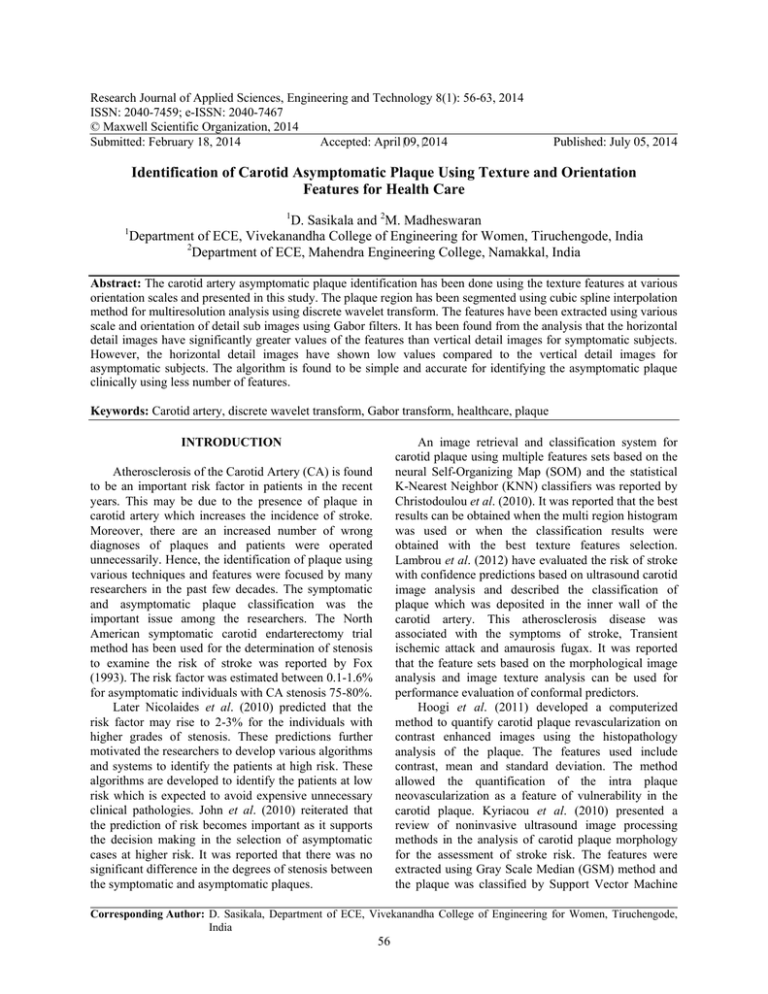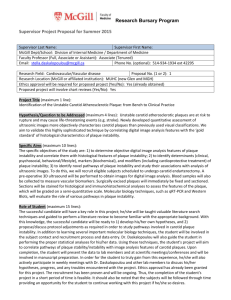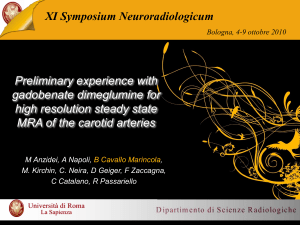Research Journal of Applied Sciences, Engineering and Technology 8(1): 56-63,... ISSN: 2040-7459; e-ISSN: 2040-7467
advertisement

Research Journal of Applied Sciences, Engineering and Technology 8(1): 56-63, 2014 ISSN: 2040-7459; e-ISSN: 2040-7467 © Maxwell Scientific Organization, 2014 Submitted: February 18, 2014 Accepted: April 09, 2014 Published: July 05, 2014 Identification of Carotid Asymptomatic Plaque Using Texture and Orientation Features for Health Care 1 D. Sasikala and 2M. Madheswaran Department of ECE, Vivekanandha College of Engineering for Women, Tiruchengode, India 2 Department of ECE, Mahendra Engineering College, Namakkal, India 1 Abstract: The carotid artery asymptomatic plaque identification has been done using the texture features at various orientation scales and presented in this study. The plaque region has been segmented using cubic spline interpolation method for multiresolution analysis using discrete wavelet transform. The features have been extracted using various scale and orientation of detail sub images using Gabor filters. It has been found from the analysis that the horizontal detail images have significantly greater values of the features than vertical detail images for symptomatic subjects. However, the horizontal detail images have shown low values compared to the vertical detail images for asymptomatic subjects. The algorithm is found to be simple and accurate for identifying the asymptomatic plaque clinically using less number of features. Keywords: Carotid artery, discrete wavelet transform, Gabor transform, healthcare, plaque An image retrieval and classification system for carotid plaque using multiple features sets based on the neural Self-Organizing Map (SOM) and the statistical K-Nearest Neighbor (KNN) classifiers was reported by Christodoulou et al. (2010). It was reported that the best results can be obtained when the multi region histogram was used or when the classification results were obtained with the best texture features selection. Lambrou et al. (2012) have evaluated the risk of stroke with confidence predictions based on ultrasound carotid image analysis and described the classification of plaque which was deposited in the inner wall of the carotid artery. This atherosclerosis disease was associated with the symptoms of stroke, Transient ischemic attack and amaurosis fugax. It was reported that the feature sets based on the morphological image analysis and image texture analysis can be used for performance evaluation of conformal predictors. Hoogi et al. (2011) developed a computerized method to quantify carotid plaque revascularization on contrast enhanced images using the histopathology analysis of the plaque. The features used include contrast, mean and standard deviation. The method allowed the quantification of the intra plaque neovascularization as a feature of vulnerability in the carotid plaque. Kyriacou et al. (2010) presented a review of noninvasive ultrasound image processing methods in the analysis of carotid plaque morphology for the assessment of stroke risk. The features were extracted using Gray Scale Median (GSM) method and the plaque was classified by Support Vector Machine INTRODUCTION Atherosclerosis of the Carotid Artery (CA) is found to be an important risk factor in patients in the recent years. This may be due to the presence of plaque in carotid artery which increases the incidence of stroke. Moreover, there are an increased number of wrong diagnoses of plaques and patients were operated unnecessarily. Hence, the identification of plaque using various techniques and features were focused by many researchers in the past few decades. The symptomatic and asymptomatic plaque classification was the important issue among the researchers. The North American symptomatic carotid endarterectomy trial method has been used for the determination of stenosis to examine the risk of stroke was reported by Fox (1993). The risk factor was estimated between 0.1-1.6% for asymptomatic individuals with CA stenosis 75-80%. Later Nicolaides et al. (2010) predicted that the risk factor may rise to 2-3% for the individuals with higher grades of stenosis. These predictions further motivated the researchers to develop various algorithms and systems to identify the patients at high risk. These algorithms are developed to identify the patients at low risk which is expected to avoid expensive unnecessary clinical pathologies. John et al. (2010) reiterated that the prediction of risk becomes important as it supports the decision making in the selection of asymptomatic cases at higher risk. It was reported that there was no significant difference in the degrees of stenosis between the symptomatic and asymptomatic plaques. Corresponding Author: D. Sasikala, Department of ECE, Vivekanandha College of Engineering for Women, Tiruchengode, India 56 Res. J. Appl. Sci. Eng. Technol., 8(1): 56-63, 2014 (SVM), K-Nearest Neighbor (KNN), Self-Organization Map (SOM) and Radial Basis Function (RBF). The best classification results were at 73% using the SVM classifier with multilevel morphological features. Due to the large number of parameters involved, many variations in the results were found in the prediction. Later, Kyriacou et al. (2012) presented the prediction of high-risk asymptomatic carotid plaques. The addition of ultrasonic plaque texture features with clinical features is found to improve the ability to identify the plaques which causes the stroke and TIA. The features were obtained by second order statistics Spatial Gray Level Dependence Matrices (SGLDM). The accuracy of prediction is estimated to be 77±1.8% while using SGLDM texture features with SVM classifiers. It was also reported that the use of combined morphological features may limit the accuracy of prediction. The classification of atherosclerotic carotid plaques using morphological analysis was investigated by Kyriacou et al. (2007). The multilevel binary and gray scale morphological analysis proposed in the assessment of atherosclerotic carotid plaques provides geometric methods for decomposition of the plaques. The Probabilistic Neural Network (PNN) and Support Vector Machine (SVM) were used for classifying the pattern spectra into symptomatic or asymptomatic class. Tsiaparas et al. (2011) compared the multiresolution features for texture classification of carotid atherosclerosis from B-mode ultrasound images. The possibility of wavelet transforms to characterize the texture of carotid atheromatous plaque tissue from Bmode ultra sound images was presented. The Discrete Wavelet Transform (DWT), Stationary Wavelet Transform (SWT), Wavelets Packets (WP) and Gabor transform were used to decompose the carotid plaque. The features selected mainly include the divergence value and nonlinear threshold value of texture along with mean and standard deviation. Then the SVM and the Probabilistic Neural Networks (PNN) were able to differentiate the plaque by the results of decompositions. The accuracy of 62.5% was found for SVM method. The plaque tissue characterization and classification in ultrasound carotid scans as a paradigm for vascular feature amalgamation was presented by Acharya et al. (2012). The characterization was based on many features extracted by Local Binary Pattern (LBP), Fuzzy Gray Level Co-occurrence Matrix (FGLCM) and Fuzzy Run Length Matrix (FRLM). These features along with degree of stenosis were used to train and test the classification of plaque by support vector machine. The proposed Plaque Risk Index (PRI) has unique range for both plaque classes. The SVM has shown higher accuracy with 83.3% of sensitivity and 95.39% of specificity. The limitation was lower accuracy for asymptomatic plaque classification. Earlier Acharya et al. (2011), proposed the classification of carotid ultrasound plaque using a combination of HOS and DWT texture analysis. The support vector machine and Radial Basis Function (RBF) were used. The classifier with kernel has achieved accuracy with 91.7% of sensitivity and 80% of specificity. It was reported that the RBF performance was poor compared to SVM classifier. The combination of spatial gray level dependence matrix and SVM classifier is found to increase accuracy compared to other combinations. Kakkos et al. (2011) proposed the computerized texture analysis of carotid plaque to identify the unstable plaques associated with ipsilateral neurological symptoms. This distinguishes the carotid plaques with neurological ipsilateral symptoms like stroke, transient ischemic attack and amaurosis fugax. The features were extracted by histogram measures, first-order gray level parameters, including GSM, Spatial Gray Level Dependence Matrices (SGLDM), Gray Level Difference Statistics (GLDS), Gray level run length statistics and Fourier Power Spectrum (FPS).The carotid plaque classification is based on the results of SGLDM correlation, skewness and PPCS (Percentage of Pixels of each of the 5 Contours of the 0 to 51 gray level Spectrum). Keeping the above facts, it is clear that there is a high demand for the development of improved plaque identification for better clinical decision making. In this study, the plaque identification is done using detail sub image features by enhancing at various scales and orientation of patterns. Christodoulou et al. (2003a) and Elatrozy et al. (1998) stated that the ultrasound images of CA undergo standardization before processing. Wavelet based texture feature analysis of plaque image along with Gabor filters can retrieve image information using texture directions (Christodoulou et al., 2003b; John et al., 2009; Yoshida et al., 2003). Thus it is necessary to classify and identify asymptomatic plaques for treating the risky asymptomatic patients at the earliest. This study proposes Gabor transforms analysis of the detailed sub images of DWT for 5 scales and 7 orientations towards identifying the asymptomatic plaques of the carotid artery. MATERIALS AND METHODS Atheromatous plaques of carotid artery were investigated for characterization as symptomatic or asymptomatic. Symptoms included stroke, hemispheric transient ischemic attack and amaurosis fugax. The sequence of longitudinal images was recorded with an ATL (Advanced Technology Laboratory) Ultra mark 4 Duplex scanner and a high resolution 7.5 MHz linear scan head. Figure 1 shows images of symptomatic and asymptomatic subjects. The images were standardized manually by linearly adjusting the image so that the 57 Res. J. Appl. Sci. Eng. Technol., 8(1): 56-63, 2014 Fig. 1: a) View of carotid ultrasound asymptomatic subject, b) view of carotid ultrasound symptomatic subject median gray level value of the blood was 0 and the median gray level value of the adventitia (artery wall) was 190 (Christodoulou et al., 2003b). This standardization of blood and adventitia as reference points becomes necessary to extract the comparable measurements in case of processing images obtained by different operators or different equipment (Elatrozy et al., 1998; Tsiaparas et al., 2011). The flow graph for identification of plaque is shown in Fig. 2. The images were obtained then the features were extracted after preprocessing. Despeckling: The speckled pixels are detected using the neighborhood pixel information and it is replaced. As speckled pixels possess maximum deviation from its neighbors and those were replaced by the mean of the neighbors in the window selected. The mean filter used in nonlinear mode eliminates the speckle noise in the image without affecting the good pixels. Segmentation: Cubic spline interpolation can be used to interpolate between known data points due to its stable and smooth characteristics. The method 58 Res. J. Appl. Sci. Eng. Technol., 8(1): 56-63, 2014 filters. Each of these images represents the image information at a certain scale and at certain orientation. For a given image I (x,y) with size PxQ, its discrete Gabor wavelet transform (John et al., 2009) is given by the convolution: Start Input carotid image Replacing speckled pixels with mean of neighborhood window ∗ (𝑠𝑠, 𝑡𝑡) 𝐺𝐺𝑚𝑚𝑚𝑚 (𝑥𝑥, 𝑦𝑦) = ∑𝑠𝑠 ∑𝑡𝑡 𝐼𝐼(𝑥𝑥 − 𝑠𝑠, 𝑦𝑦 − 𝑡𝑡). 𝜑𝜑𝑚𝑚𝑚𝑚 where, s, t are the filter mask size variables, generated from dilation and rotation of the following mother wavelet: De speckled image Cubic spline interpolation to segment plaque 𝜑𝜑(𝑥𝑥, 𝑦𝑦) = DWT on plaque Approximation detail image Horizontal detail image Vertical detail image Gabor transform Features extracted Features extracted Is horizontal detail image feature values > vertical detail image feature values 1 2𝜋𝜋𝜎𝜎𝑥𝑥 𝜎𝜎𝑦𝑦 𝑒𝑒 1 𝑥𝑥 2 𝑦𝑦 2 −2 � 2 + 2 � 𝜎𝜎 𝜎𝜎 𝑥𝑥 𝑦𝑦 𝑒𝑒 𝑗𝑗 2𝜋𝜋𝑊𝑊𝑥𝑥 (2) where, Wx = Modulation frequency 𝜑𝜑(𝑥𝑥, 𝑦𝑦) = Gaussian modulated by a complex sinusoid Diagonal detail image Gabor transform The self-similar Gabor wavelets can be obtained through the generating function: 𝜑𝜑𝑚𝑚𝑚𝑚 (𝑥𝑥, 𝑦𝑦) = 𝑎𝑎−𝑚𝑚 𝜑𝜑(𝑥𝑥�, 𝑦𝑦�) (3) 𝑥𝑥� = 𝑎𝑎−𝑚𝑚 (𝑥𝑥𝑥𝑥𝑥𝑥𝑥𝑥𝑥𝑥 + 𝑦𝑦𝑦𝑦𝑦𝑦𝑦𝑦𝑦𝑦) (4) where, m and n specify the scale and orientation of the wavelet respectively. In addition: 𝑦𝑦� = 𝑎𝑎−𝑚𝑚 (−𝑥𝑥𝑥𝑥𝑥𝑥𝑥𝑥𝑥𝑥 + 𝑦𝑦𝑦𝑦𝑦𝑦𝑦𝑦𝑦𝑦) No (5) where, α>1, θ = nπ/Ν: 1 𝑎𝑎 = (𝑈𝑈𝑈𝑈ℎ )𝑀𝑀 −1 𝐼𝐼 Yes Symptomatic plaque (1) (6) 𝑊𝑊𝑥𝑥,𝑚𝑚 ,𝑛𝑛 = 𝑎𝑎𝑚𝑚 . 𝑈𝑈𝐼𝐼 Asymptomatic plaque 𝜎𝜎𝑥𝑥,𝑚𝑚 ,𝑛𝑛 = Fig. 2: Flow graph for identification of asymptomatic plaque 𝜎𝜎𝑦𝑦,𝑚𝑚 ,𝑛𝑛 = combines the smooth curve characteristics of spline interpolation with the non-overshooting behavior of linear interpolation. The identified region of interest is marked through several continuous points. After connecting the points together by cubic spline interpolation, the plaque from the symptomatic and asymptomatic subjects are cut out using binary masks for analysis. (7) (𝑎𝑎+1)√2 𝑙𝑙𝑙𝑙 2 2𝜋𝜋 𝑎𝑎 𝑚𝑚 (𝑎𝑎−1)𝑈𝑈𝐼𝐼 2𝜋𝜋 tan � (8) 1 2 𝜋𝜋 � 𝑈𝑈 ℎ 1 )2 � 2 𝑙𝑙𝑙𝑙 2 −(2𝜋𝜋 𝜎𝜎 2𝑁𝑁 𝑥𝑥,𝑚𝑚 ,𝑛𝑛 (9) Here a is the scale factor, 𝑈𝑈ℎ corresponds to the highest central frequency and 𝑈𝑈𝐼𝐼 to the lowest central frequency of interest. Features are extracted using Gabor transform under 5 different scales and 7 orientations over the detail sub images decomposed using DWT. Totally 70 feature values were extracted for each detail sub image. The features include the mean 𝜇𝜇𝑗𝑗 and entropy 𝐸𝐸𝑗𝑗 obtained from the decomposed images at first level that are defined as: Feature extraction: Image details at multiple resolutions were characterized using the texture features extracted from detail sub images of wavelet transform applied over the carotid atheromatous plaque from the ultrasound images. The asymptomatic image can be differentiated using discrete wavelet decomposition combined with Gabor transform under five different scales and seven orientations. A set of filtered images can be obtained by convolving the image with Gabor 𝜇𝜇𝑗𝑗 = 59 1 𝑁𝑁𝑁𝑁 𝑀𝑀 ∑𝑁𝑁 𝑥𝑥=1 ∑𝑦𝑦=1�𝐷𝐷𝑗𝑗 (𝑥𝑥, 𝑦𝑦)� 𝑀𝑀 𝐸𝐸𝑗𝑗 = ∑𝑁𝑁 𝑥𝑥=1 ∑𝑦𝑦=1 𝐷𝐷𝑗𝑗 (𝑥𝑥, 𝑦𝑦) log 𝐷𝐷𝑗𝑗 (𝑥𝑥, 𝑦𝑦) (10) (11) Res. J. Appl. Sci. Eng. Technol., 8(1): 56-63, 2014 where, D j (x, y) are the detail sub images of dimension N×M in every orientation at level j = 1, 2 and 3. With the help of features extracted, the plaque can be characterized as symptomatic or asymptomatic. RESULTS AND DISCUSSION Fig. 3: (a) Asymptomatic subject marked with region of interest, (b) symptomatic subject marked with region of interest The plaque characterization using soft computing techniques was done using MATLAB. The images were preprocessed and the required features were extracted for identification. The multiresolution analysis of plaques of asymptomatic and symptomatic plaque images shown in Fig. 3a and b is performed using Gabor transform under various scales over the decomposed sub images obtained from DWT. The sub images are approximation detail image, horizontal detail image, vertical detail image and the diagonal detail image from each level. The texture features namely the mean and entropy are extracted under 5 different scales for 7 different orientations using Gabor transform for each sub image. Each feature is evaluated in 35 different modes so that 70 different features were extracted for each detail sub image and all the features were used for identification. The features from the approximation image and diagonal detail images do not show difference between the symptomatic and asymptomatic plaques. Figure 4 and 5 show the horizontal and vertical detail sub images obtained from DWT for asymptomatic and symptomatic plaque subjects respectively. It was observed that most of the horizontal detail images have produced features whose values are greater than the vertical detail images for symptomatic subjects. It is Fig. 4: (a) Horizontal detail subimages of asymptomatic plaque subjects, (b) vertical detail subimages of asymptomatic plaque subjects Fig. 5: (a) Horizontal detail subimages of symptomatic plaque subjects, (b) vertical detail subimages of symptomatic plaque subjects Fig. 6: Variation of mean with orientation for asymptomatic horizontal and vertical detail images 60 Res. J. Appl. Sci. Eng. Technol., 8(1): 56-63, 2014 Fig. 7: Variation of entropy with orientation for asymptomatic horizontal and vertical detail images Fig. 8: Variation of mean with orientation for symptomatic horizontal and vertical detail images also observed that for asymptomatic plaque subjects the horizontal detail images has produced more features whose values are less than the vertical detail images. Thus the proposed method proves to be better and less complex in identifying the plaques by the physicians without much computation during diagnosis. The proposed method of feature extraction reduces the time and complexity of the algorithm as features extracted from the horizontal and vertical detail sub images of the same class is compared hence misclassification is avoided. The method is tested on 20 symptomatic and 20 asymptomatic subjects. Figure 6 and 7 shows the variation of mean and entropy of horizontal and vertical detail sub images of asymptomatic plaque subjects plotted for 7 orientations (0, 30, 45, 60, 90, 120, 135 degrees, respectively) under 5 scales. It is observed that the values for vertical detail images are significantly greater than the horizontal detail images for all 5 scales. The distance between the features values of the sub images are prominent with increase in scale values. 61 Res. J. Appl. Sci. Eng. Technol., 8(1): 56-63, 2014 Fig. 9: Variation of entropy with orientation for symptomatic horizontal and vertical detail images Figure 8 and 9 shows the variation of mean and entropy of horizontal and vertical detail sub images of symptomatic plaque subjects plotted for 7 orientations under 5 scales. It is observed that the values for vertical detail images are significantly less than the horizontal detail images for all 5 scales. The distance between the features of the sub images are prominent with increase in scale values. Christodoulou, C.I., C.S. Pattichis, M. Pantziaris and A. Nicolaides, 2003a. Texture-based classification of atherosclerotic carotid plaques. IEEE T. Med. Imaging, 22(7): 902-912. Christodoulou, C.I., C.S. Pattichis, E. Kyriacou and A. Nicolaides, 2010. Image retrieval and classification of carotid plaque ultrasound images. Open Cardiovasc. Imaging J., 2: 18-28. Christodoulou, C.I., E. Kyriacou, M.S. Pattichis, C.S. Pattichis and A. Nicolaides, 2003b. A comparative study of morphological and other texture features for the characterization of atherosclerotic carotid plaques. Proceeding of the 10th International Conference on Computer Analysis of Images and Patterns (CAIP, 2003), LNCS 2756, pp: 503-511. Elatrozy, T., A. Nicolaides, T. Tegos, A. Zarka, M. Griffin and M. Sabetai, 1998. The effect of Bmode ultrasonic image standardisation on the echogenicity of symptomatic and asympto-matic carotid bifurcation plaques. Int. Angiol., 17(3): 179-186. Fox, A., 1993. How to measure carotid stenosis. Radiology, 186: 316-318. Hoogi, A., D. Adam, A. Hoffman, H. Kerner, S. Reisner and D. Gaitini, 2011. Carotid plaque vulnerability: Quantification of neovascularization on contrast-enhanced ultrasound with histopathology correlation. Am. J. Roentgenol., 196: 431-436. John, S., G. Spyretta, T. Nikolaos and S.N. Konstantina, 2009. Texture characterization of carotid atherosclerotic plaque from B-mode ultrasound using Gabor filters. Proceeding of the 31st Annual International Conference of the IEEE Engineering in Medicine and Biology Society (EMBS, 2009), pp: 455-458. CONCLUSION The features of carotid artery have been estimated for identifying asymptomatic plaque using soft computing techniques. The features such as mean and entropy have been utilized under various orientations of the image for identification. It is concluded from the observations that these features can accurately identify the asymptomatic plaque without error. Further it is seen from the analysis that the use of advanced classifiers may not be required for the identification. REFERENCES Acharya, U.R., O. Faust, V.S. Sree, A.P.C. Alvin, G. Krishnamurthi, J.C. Seabra, J. Sanches and J.S. Suri, 2011. Atheromatic™: Symptomatic vs. asymptomatic classification of carotid ultrasound plaque using a combination of HOS, DWT and texture. Proceeding of the Annual International Conference of the IEEE Engineering in Medicine and Biology Society, Aug. 30-Sept. 3, IEEE Xplore Press, Boston, MA, pp: 4489-4492. Acharya, U.R., M.M.R. Krishnan, S.V. Sree, J. Sanches, S. Shafique, A. Nicolaides, L.M. Pedro and J.S. Suri, 2012. Plaque tissue characterization and classification in ultrasound carotid scans: A paradigm for vascular feature amalgamation. IEEE T. Instrum. Meas., 16(4):1-9. 62 Res. J. Appl. Sci. Eng. Technol., 8(1): 56-63, 2014 Kakkos, S.K., A.N. Nicolaides, E. Kyriacou, S.S. Daskalopoulou, M.M. Sabetai, C.S. Pattichis, G. Geroulakos, M.B. Griffin and D. Thomas, 2011. Computerized texture analysis of carotid plaque ultrasonic images can identify unstable plaques associated with ipsilateral neurological symptoms. Angiology, 62(4): 317-328. Kyriacou, E.C., C. Pattichis, M. Pattichis, C. Loizou, C. Christodoulou, S.K. Kakkos and A. Nicolaides, 2010. A review of noninvasive ultrasound image processing methods in the analysis of carotid plaque morphology for the assessment of stroke risk. IEEE T. Inf. Technol. B., 14(4): 1027-1038. Kyriacou, E.C., S. Petroudi, C.S. Pattichis, M.S. Pattichis, M. Griffin, S. Kakkos and A. Nicolaides, 2012. Prediction of high-risk asymptomatic carotid plaques based on ultrasonic image features. IEEE T. Inf. Technol. B., 16(5): 966-973. Kyriacou, E., M.S. Pattichis, C.S. Pattichis, A. Mavrommatis, C.I. Christodoulou, S. Kakkos and A. Nicolaides, 2007. Classification of atherosclerotic carotid plaques using morphological analysis on ultrasound images. Appl. Intell., 30: 3-23. Lambrou, A., H. Papadopoulos, E. Kyriacou, C.S. Pattichis, M.S. Pattichis, A. Gammerman and A. Nicolaides, 2012. Evaluation of the risk of stroke with confidence predictions based on ultrasound carotid image analysis. Int. J. Artif. Intell. T., 21(4): 1-18. Nicolaides, A., S. Kakkos, E. Kyriacou, M. Griffin, M. Sabetai, D.J. Thomas, T. Tegos, G. Geroulakos, N. Labropoulos, C.J. Dore, T.P. Morris, R. Naylor and A.L. Abbott, 2010. Asymptomatic internal carotid artery stenosis and cerebrovascular risk stratification. J. Vasc. Surg., 52(4): 1486-1496. Tsiaparas, N.N., S. Golemati, I. Andreadis, J.S. Stoitsis, I. Valavanis and K.S. Nikita, 2011. Comparison of multiresolution features for texture classification of carotid atherosclerosis from B-mode ultrasound. IEEE T. Inf. Technol. B., 15(1): 130-137. Yoshida, H., D.D. Casalino, B. Keserci, A. Coskun, O. Ozturk and A. Savranlar, 2003. Wavelet-packetbased texture analysis for differentiation between benign and malignant liver tumors in ultrasound images. Phys. Med. Biol., 48: 3735-3753. 63



